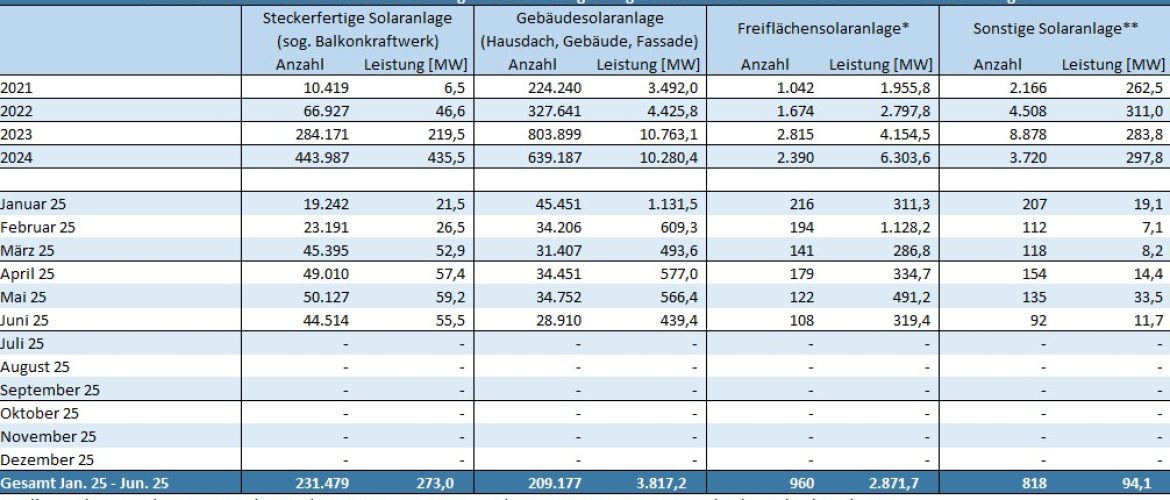With an estimated newly installed capacity of 905 megawatts,
photovoltaic capacity expansion remains significantly below the previous year’s level. The Market Data Register reports that photovoltaic systems added just over 7,000 megawatts in the first half of the year.

The Federal Network Agency (BNetzA) expects a net addition of approximately 904.6 megawatts of photovoltaic capacity for June. It estimates the additions based on the registrations of new photovoltaic systems recorded in the market data register up to July 14. By that point, net additions had reached 822.6 megawatts. However, since system operators report new installations with a one-month delay, experts expect the total to increase further. Due to the relatively consistent reporting pattern, it calculates a ten percent increase for the official additions figure for the month.
After a brief recovery and an addition of more than one gigawatt in May, Germany failed once again to maintain that level. In March, newly installed photovoltaic capacity reached only 835 megawatts. In April, it stood at 978 megawatts—both below the gigawatt mark. The Federal Network Agency reports that photovoltaic systems expanded by around 7,100 megawatts during the first half of the year. This reflects a slower pace of photovoltaic capacity expansion.
More than 3,230 megawatts came from January and February alone. Since the end of February, the “Solar Peak Act” has applied to new systems. Among other changes, this law stops remuneration during periods of negative electricity prices on the stock exchange. In the first half of the year, such conditions occurred for 389 hours.
The Federal Network Agency’s detailed analysis shows that demand for rooftop photovoltaic systems remains weak and is even declining. In June, this segment accounted for 439.4 megawatts of new capacity installed, spread across 28,910 new photovoltaic systems. This is the weakest figure so far this year.

Ground-mounted photovoltaic systems also recorded a rather poor performance, with 319.4 megawatts and 108 new power plants. Other solar systems, which include photovoltaic systems in parking lots, on noise barriers, and other structures, recorded an increase of 11.7 megawatts.
Demand for plug-in solar devices, on the other hand, appears relatively stable. The Federal Network Agency recorded 44,514 new registrations for June, with a total capacity of 55.5 megawatts. Since March, newly installed capacity in this segment has remained constant between 50 and 60 megawatts. Since then, the number of newly registered plug-in solar devices has also exceeded the number of new rooftop systems.
The net additions for the first half of the year, calculated by the Federal Network Agency at exactly 7,018.2 megawatts, include all commissionings minus decommissionings during this period. In terms of segments, this results in a newly installed gross capacity of 273 megawatts for plug-in solar devices, 3,817 megawatts for rooftop systems, 2,872 megawatts for ground-mounted systems, and 94 megawatts for other systems in the first half of the year.
The cumulative installed photovoltaic capacity reached 107,373 gigawatts by the end of June. A total of 5,285,795 photovoltaic systems were registered in the market data register.
The calculation of ten percent of late registrations for photovoltaic systems is very conservative. This is demonstrated by a comparison of previous month’s figures, in which all new installations since January have been revised upwards in the current document. A month ago, new installations in January were still at 1,443 megawatts and are now reported at 1,475 megawatts. For February, the correction was from 1,754 to 1,762 megawatts, for March from 817 to 835 megawatts, for April from 945 to 978 megawatts, and for May from 1,113 to 1,146 megawatts.



